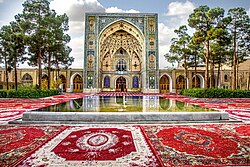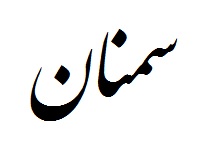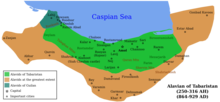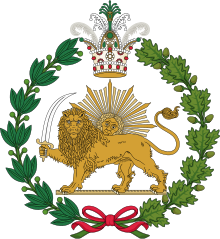
A | B | C | D | E | F | G | H | CH | I | J | K | L | M | N | O | P | Q | R | S | T | U | V | W | X | Y | Z | 0 | 1 | 2 | 3 | 4 | 5 | 6 | 7 | 8 | 9
Semnan
سمنان، سَمَن also known as Saman | |
|---|---|
City | |
 Imam Soltani mosque | |
| Nickname: City of Compassion[1] | |
| Motto(s): Welcome; خوش امیچین | |
| Coordinates: 35°34′52″N 53°23′00″E / 35.58111°N 53.38333°E[2] | |
| Country | Iran |
| Province | Semnan |
| County | Semnan |
| District | Central |
| Settled | circa 240BCE by Parni tribesmen |
| Incorporated (city) | 1926 |
| Government | |
| • Type | Municipality |
| • Mayor | Seyed Hossein Mousavi[3] |
| Elevation | 1,130 m (3,707 ft) |
| Population (2016)[4] | |
| • Total | 185,129 |
| Time zone | UTC+3:30 (IRST) |
| Area code | +98 23 |
| Main Languages | Persian, Semnani |
| Climate | BWh |
| Website | www |
Semnan (Persian: سمنان; pronounced [semˈnɒːn] )[a] is a city in the Central District of Semnan County, Semnan province, Iran, serving as capital of the province, the county and the district.[6] The city is on the alluvial fan of the Golrudbar creek in the north-central part of the country, 216 km east of Tehran and 640 km west of Mashhad. With a population of 185,129 people in 2016,[4] Semnan is the most populous city in the province and the hub of the Semnani language, a sub-branch of the Iranian languages spoken to the north. It is home to the Semnani ethnic group.
Semnan offers various recreational activities; historical and religious sites; festivals, gardens and parks; and centers of higher education and Semnani culture. The city is the cultural and political capital of Semnan province. The city's main souvenirs are daffodil flowers, Shirmal pastry, Kolüçe cookies, kilim rugs, and shortbread.
Etymology

There are several theories which seek to explain the origin of the name Semnan.
- Semnan was an ancient pre-zoroastrian city in which the locals practiced idol-worshipping. Their religion was called samīna, hence the name Semnan.
- Semnan was an ancient civil establishment by the Scythians, an Iranian people who named their settlement Sakanān.
- A theory produced by the local people themselves claims the first settlers of Semnan were two of the Prophet Noah's children, Sim An-Nabi and Lam An-Nabi, and that their settlement became known as Simlam; the local people believe that over time the name Simlam turned into Semnan.
- Semnan was established by the mythical character Tahmuras, and that he named his city Saminā.
- The ancient regional language was known as Sa ma nān, and that the city of these people took on the name of their language.
- The name Semnan comes from the phrase sa ma nān, which is supposed to be a corrupted Persian way of saying 'three months of bread.' This phrase traces back to the Semnani women's tradition of cooking three months worth of bread in one day.[7]
History
Pre-Islamic Era

The city of Semnan has historically been one of the fourteen civil establishments of the ancient, Avesta-era province of "Vern."[8] Semnan remained an important city throughout the era of the Persian Achaemenid Empire. After the invasion of Alexander the Great, which resulted in the fall of the Achaemenid Empire, and the establishment of the Seleucid Empire, the region which hosts the city of Semnan became known as Komesh. The beginning of the prosperous era of the city arrived with the rise of the Arsacid dynasty of Parthia. The Parthians are an Iranian people. The Arsacid dynasty of Parthia was very interested in the importing of Hellenism, or Greek culture. This resulted in the pioneering of sculpting and other forms of Western art in the city of Semnan. One of the capital cities of the Parthian Empire was Hecatompylos, and its ruins and numerous historical sites remain between the modern day city of Semnan and Damghan. With the fall of the Parthian Empire, and the rise of the Persian Sassanid Empire, Zoroastrianism was chosen as the state religion, and the city of Semnan was once again brought under the reign of Persian customs and traditions.
Post-Islamic Era

After the Muslim conquest of Persia, the religion of Islam was established within the city of Semnan. Though, unlike modern day Semnan, the people of the city originally practiced Sunni Islam, similar to the rest of early Islamic Persia. However, the institution of Sunni Islam did not last very long. The Alavids of Tabaristan had established a Shi'a Islamic emirate and upon conquering Semnan, brought the Zaidi Shi'a sect of Islam. Then, in the year 427 AH, the Seljuq Turks invaded and devastated the city. Nevertheless, it was the very Seljuq Turks that built many of the historical monuments and infrastructure of medieval Semnan.[9] As the Seljuq Empire grew weak, the Abbasids managed to reconquer and assert their sovereignty over Persia. The people of Semnan suffered severely under the Abbasid Caliphate. It is possible that the years of Abbasid rule traumatized the people of Semnan, and even to this day, the Semnani people despise the color black because of its utilization for the black flags of the Abbasid Caliphate.[8] The Abbasid rule was ended by the brutal, devastating invasion of the Mongols in the year of 618 AH. The Mongol hordes massacred the people and burnt much of the city to the ground. Semnan would not recover until the rise of the Turco-Persian Safavid dynasty. The Safavids brought the Twelver Shi'ism sect of Islam to Semnan, and contributed to the reconstruction of the city.
Qajar Era

With the rise of the Qajar dynasty, historical Semnan witnessed economical, cultural, infrastructural, and political progress. The very tribe that rose into becoming the Qajar dynasty was based out of the mountainous terrain between modern-day Semnan, Mazandaran, and Golestan. The Qajars turned Semnan into a civil fortress, from which they oversaw the major trade route between their capital in Tehran and the holy city of Mashad. In addition to infrastructural growth, some Qajar royals built their estates in the city. Semnan was also an important medical center for members of the Qajar imperial family and was home to many notable physicians and doctors of the era. Economically, the city consisted of several feudal estates with agricultural plantations which relied on serf labor.
Pahlavi Era

The Pahlavi era marked the transition of Semnan into the industrial era. Semnan's original loyalty to the Qajar dynasty and the city's importance under the Qajars prompted a lot of anti-Pahlavi sentiment with the rise of Reza Shah. Reza Shah Pahlavi's government began the immediate construction of modern infrastructure and paved roads throughout the city, however, this called for the destruction of the citadel of Semnan and the artistic monuments of the Qajars. Upon attempting to destroy the Gate of Semnan, the locals chained themselves to the building and stopped its destruction. Many prominent families in Semnan were also restricted from attaining high political posts as a result of their previous connection with and service to the Qajar imperial family. This resulted in the exodus of many prominent Semnani families to Tehran during the early Pahlavi era. Despite the tension and confrontation, the Pahlavi dynasty was successful in transforming Semnan into a more modern city. Throughout the early Pahlavi era, Semnan experienced several rounds of extreme drought, famine, crop devastation, and poverty. Prominent Semnani language poets such as Nosratollah Nouhian encouraged the Farmers and General Labor class to rise up and demand their rights from the unjust, well-fed landlords who were carelessly watching the very farmers who grew the food starve and deteriorate into ruin and agony:
|
دیگه صبر و قناعت وسه پی با Patience and contentment is no more, rise up!
|
Demographics
Language and ethnicity
The Persian language is the official language of the Islamic Republic of Iran, and thus within the city of Semnan. Every literate person in Semnan knows how to communicate in the Persian language.
The majority of the city dwellers are Persians. Older Semnan was made up of four main districts: Shaji (Shahjoo), Naasaar, Latibaar and Espanjon (Esfanjan). These four districts still exist today, but the city has grown and become much larger including some new districts. To the west of the city is "Maleh" which used to be a separate settlement but was not a part of Semnan. In the local language the inhabitants are known as Malezh. "Maleh" consists of three parts: Koery (Kodivar), Koshmeni (Kushmaqaan) and Zaveni (Zavaqaan). "Maleh" is now part of Semnan.
As a result of the Qajar dynasty's heavy influence on the city of Semnan, especially under Fath Ali Shah's reign, some families in Semnan can trace their lineage back to the Qajar dynasty. Furthermore, much of the city's most important monuments have been built under Turkic dynasties. For example, the Jame' Mosque of Semnan, constructed nearly 1,000 years ago, was built by the Seljuq dynasty. The Imam Mosque, originally known as Soltani Mosque, was constructed by the Qajar dynasty. The Gate of Semman, or Arg e Semnan, which is the representative symbol of the city of Semnan, was also constructed by the Qajar dynasty. Many other historical sites within the city and the surrounding villages demonstrate a strong Turkic and Ilkhanate influence in their architectural designs.
Also, much of the city's Sayyid population tends to descend from the Alavids of the Caspian region to the north of the province.
Semnani language
The city also has its own language known as "Zaban e Semnani" in Persian or "Semani Zefön" in the Semnani language of the locals. The Iranian Constitution recognizes the use of regional dialects and languages, and permits their usage second to the Persian language.
According to the book Dictionary of Semnan Ancient Dialect, Semnan traditionally has had its own language. The book collected more than 12,000 words belonging to this language. The local people call their language Semani. Most of the older generations and some among the younger generations of the city still know and maintain communication in this language. However, the majority of the younger generations do not communicate in Semani as a result of schooling and education in Persian.[10]
Religion
The people of the city of Semnan are almost all entirely Shi'a Muslim. The Shi'a Islamic faith dominates the culture, norms, traditions, and beliefs of the city, and continues to dictate the style of life in city. As a result, the celebrations, rituals, and days of religious mourning play a major role in the life of a Semnani city dweller, and are for some families, more important that the national Iranian customs and holidays. The majority of the people of Semnan observe Shi'a Islam quite conservatively; hence, the martyrdom and birthdays of Shi'a Imams are very important days on the calendar.
Population
At the time of the 2006 National Census, the city's population was 124,999 in 36,298 households.[11] The following census in 2011 counted 153,680 people in 45,311 households.[12] The 2016 census measured the population of the city as 185,129 people in 49,124 households.[4]
Geography
Location

The city of Semnan is situated on an alluvial fan at 1,138 metres above sea level, straddling the southern foothills of the Alborz Mountains and the vast desert plain to the south of the city. The Golrudbar creek, which begins in the mountains to the north of Shahmirzad, has historically provided a reliable supply of water for municipal and agricultural consumption. Irrigation methods since ancient times have allowed the people of Semnan to drink clean water, raise livestock such as cattle and sheep, and cultivate diverse crops.
Climate
This section needs additional citations for verification. (September 2023) |
Semnan has a hot desert climate (BWh) bordering a cold desert climate (BWk) according to the Köppen climate classification. The city enjoys the traditional four seasons of winter, spring, summer, and autumn each year.
The rain season starts in December and lasts into May, however, precipitation throughout the rain season is generally very light. During some winters, moisture-abundant blizzards make their way down from the Alborz mountains to the north of the city and dump several centimeters of snow in a single twenty-four-hour period[citation needed]. As a result of the city's position straddling the open desert plain, many winter days are dominated by a cold and gusty wind that often produces a potent windchill factor which makes the city feel much colder than the actual air temperature. According to Iranian Meteorological statistics, Semnan experiences around 44.5 days in which the minimum temperature falls below freezing each year.[13]
Spring is characterized by mild to warm day temperatures and cold to cool nights. Muinimun Temperatures do not fall below freezing from May to October and rarely do so in March, April and November.[13]
Summers are often hot during the day and mildly warm at night. Summer months remain extremely dry with only trace amounts of rain. Occasionally, moisture from the Caspian Sea passes over the High Alborz. With the right amount of heat and moisture, thunderstorms may develop during the afternoon and evening hours. Though the amount of precipitation is light, these thunderstorms often produce strong and gusty winds with frequent lightning strikes.[citation needed]
Autumn is mostly a transitional season.
| Climate data for Semnan (1965-2010, records and temperature normals 1965-2020) | |||||||||||||
|---|---|---|---|---|---|---|---|---|---|---|---|---|---|
| Month | Jan | Feb | Mar | Apr | May | Jun | Jul | Aug | Sep | Oct | Nov | Dec | Year |
| Record high °C (°F) | 20.0 (68.0) |
26.4 (79.5) |
31.0 (87.8) |
35.4 (95.7) |
38.6 (101.5) |
43.0 (109.4) |
44.4 (111.9) |
43.8 (110.8) |
40.0 (104.0) |
34.4 (93.9) |
27.2 (81.0) |
20.2 (68.4) |
44.4 (111.9) |
| Mean daily maximum °C (°F) | 8.7 (47.7) |
11.6 (52.9) |
17.3 (63.1) |
24.2 (75.6) |
29.9 (85.8) |
35.6 (96.1) |
38.0 (100.4) |
36.8 (98.2) |
32.8 (91.0) |
25.4 (77.7) |
17.0 (62.6) |
10.7 (51.3) |
24.0 (75.2) |
| Daily mean °C (°F) | 4.1 (39.4) |
6.5 (43.7) |
11.8 (53.2) |
18.3 (64.9) |
23.8 (74.8) |
29.4 (84.9) |
32.0 (89.6) |
30.6 (87.1) |
26.5 (79.7) |
19.6 (67.3) |
11.9 (53.4) |
6.1 (43.0) |
18.4 (65.1) |
| Mean daily minimum °C (°F) | −0.5 (31.1) |
1.4 (34.5) |
6.3 (43.3) |
12.3 (54.1) |
17.7 (63.9) |
23.1 (73.6) |
25.9 (78.6) |
24.3 (75.7) |
20.1 (68.2) |
13.7 (56.7) |
6.7 (44.1) |
1.5 (34.7) |
12.7 (54.9) |
| Record low °C (°F) | −12.6 (9.3) |
−9.0 (15.8) |
−7 (19) |
−2.0 (28.4) |
5.0 (41.0) |
10.0 (50.0) |
16.8 (62.2) |
12.4 (54.3) |
7.0 (44.6) |
2.0 (35.6) |
−9 (16) |
−8 (18) |
−12.6 (9.3) |


